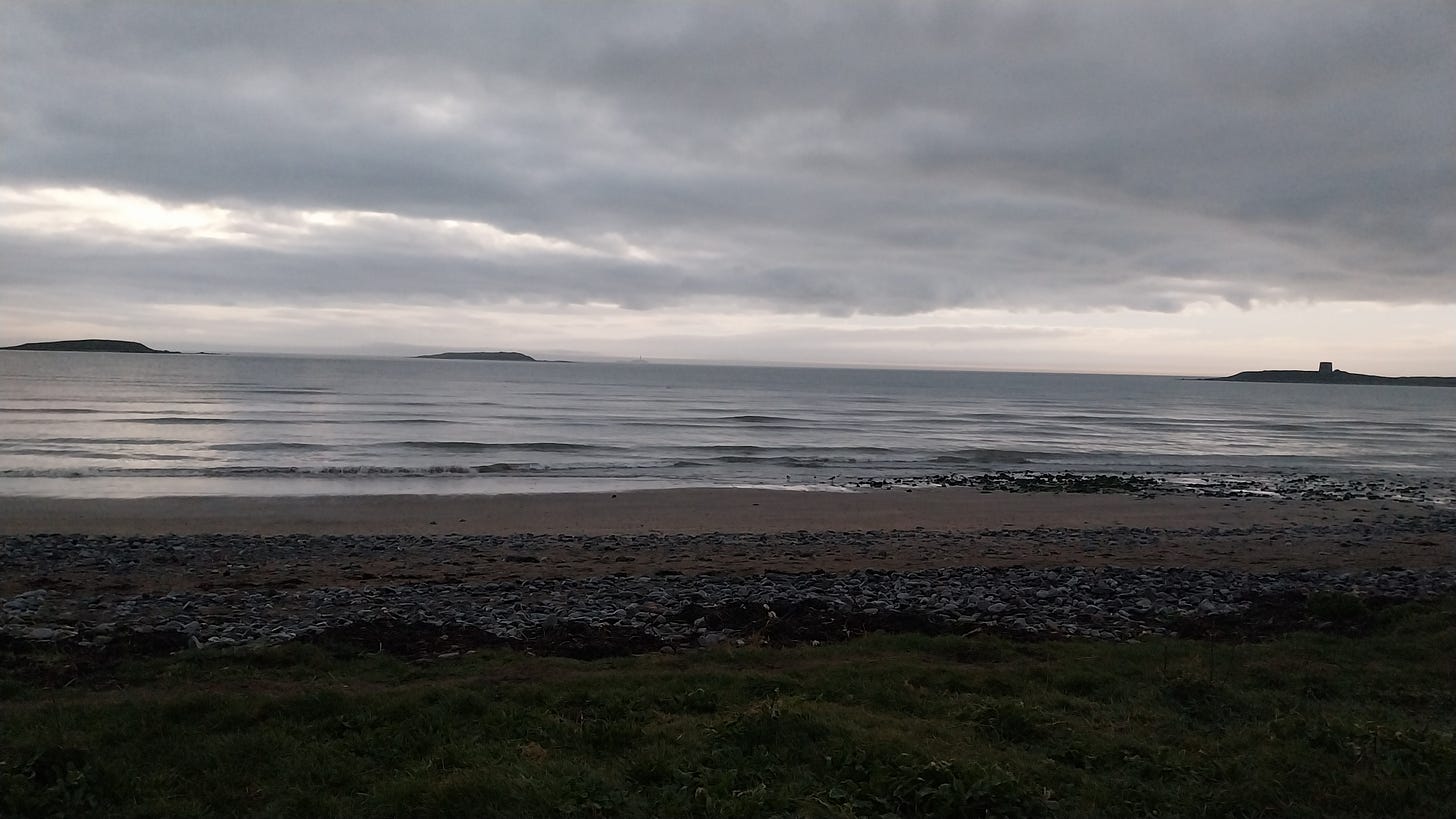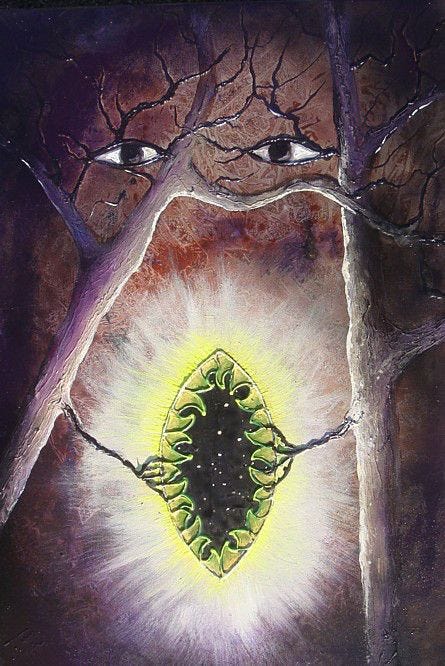Goddesses Who Create
Happy Sheelagh's Day!
Morning lovelies,
As we travel through the Gaelic season of Imbolc towards its apex at the Spring Equinox this week, we pass along the festivities of Goddess and Matron Saint of Ireland, Brigid. This is followed by the feast of St. Gobnait who like a sister saint of Brigid is also a pre-Christian goddess, into yesterday’s celebrations of St. Patrick followed by drumroll… today and Sheelagh!
When I did my degree in Medieval Irish & Celtic Studies albeit 20 years ago now, it felt like an inordinate amount of time was given to studying the hagiographies of Patrick. This persistent imbalance has gifted him synonymity with Irish culture, particularly over the last century since St. Patrick’s Day became an official public holiday. The introduction in 2023 of a new national holiday in honour of Brigid - a goddess and saint nonetheless - has felt like a rousing redemption of the feminine and a sign of rebalance in a changing Ireland.
One curious act attributed to St. Patrick by the 9th-century Bishop-King, Cormac mac Cuilennáin, is that he banned the practice of imbas forosnai, “knowledge” or “wisdom that illuminates”.1 Imbas can describe both spontaneous divine inspiration, and a ritual practice of the filí, the poet-seers of ancient Ireland. According to Cormac, it was not Patrick’s bag, if you dared to practice it, you could be tossed out of heaven and earth.
‘Patrick banished that [imbas forosnai] and the Tenm láida “illumination of song”, and declared that no one who shall do that shall belong to heaven or earth, for it is a denial of baptism’.

Cormac was writing hundreds of years after Patrick died so who knows if this was ever a reality. In ways it doesn’t matter, it’s the story that does. Why did this story need to exist? What was it in service to? What’s interesting to me, is the clue it provides about what the early Church thought about the magic of imagination in its highest divine form. Imbas is, in essence, poiesis, the art of birthing our inner creative treasures into form. It is concerned with the making of our psyche, of our soul. Today, in reclamation of imbas and celebration of Ireland’s mythological heritage, I write about six Irish Creatrix goddesses, inspired by a series I shared in 2023, which was met with love.
As part of The Celtic Creatives membership, each month I will share an in-depth Creative Ancestor Profile - an introduction to a goddess, god, archetype or mythic being within the Irish tradition who you can connect with to support your creativity.
One of these Creatrix goddesses is none other than the Baubo-esque vulva-flashing, Sheela na Gig or Síle na Gig. Today is St. Sheelagh’s Day, a lost Christian tradition which - as is usually the case in Ireland - has pre-Christian roots. (Check out Sheelah Speaks, Patrick Listens by the wonderful storyteller, Marisa Goudy for more on St. Sheelagh). Some say Sheelagh was the wife of St. Patrick, others his mother, but her story likely descends from the old Sovereignty Goddesses of Ireland. To quote Peter O’Connor:2
“The land of Ireland is still the goddess’s, no matter what name she goes by”.
If you’re in the mood for reflective practice, have your journal handy to respond to a question that each goddess will ask of you.
Sheela na Gig

Let’s kick off with the woman herself. A native to Ireland and the British Isles, Síle na Gig or Sheela na Gig is a carved stone image of a naked female figure. Most Sheela’s are found on church walls, often above doorways, on castles, and then rarely like the Sheela at the Hill of Tara, on a menhir, a lone standing stone.
Sheela’s hands emphasise her exposed genitals. Her vulva offers a ripeness, a fullness, a portal. And yet her upper body is usually depicted as hideous, grotesque, provocative; a Creatrix of life and death in one glance.
Sheela has been called by many names—a whore, a witch, a hag, the devil, an evil-eye stone, a healer and a goddess. Sheela relishes in her mystery, it’s part of her arcane feminine power.
Some Sheela’s like the Ballyvourney Sheela in Co. Cork were used by women as guardians of fertility. A woman would rub her handkerchief on Sheela’s vulva then shake the stone dust from the cloth into water, and drink from it.
Sheela reminds us that creativity as a process is messy and ugly, and our creations themselves can feel like they’re mocking us at times. But when we have the courage to climb through the portal of that cosmic vulva, we can birth our creative dreams. In doing so, we become one with the vibration of life itself.
The lush Sheela asks of you on her special day:
How might you embrace the mess of what is dreaming its way to life through you?
Go on, go for it, climb through that celestial vulva! This banger, Sheela-na-Gig by PJ Harvey, can be your accompanying montage track.
An Chailleach
Cailleach (“Kal-yach”) translates as “Veiled One” in Old Irish. Her name also means divine hag, crone, widow, nun, and most commonly, “witch” in modern Irish.
She is as old as time. She is our creator deity, our ancestor deity, our weather deity.
She is our Great Mother, our Seanmháthair Naofa, our “Sacred Grandmother”. She was once a Sovereignty Goddess, a fierce protectress of these lands and a mother to “peoples and races”, a mother to their descendants, a mother to us.
It is said that the Cailleach created the Gaelic lands of Ireland/Éire, the Isle of Man/Ellan Vannin and Scotland/Alba. She often appears in the twilight of Samhain with a veiled one-eye on ghostly blue skin dancing her bow-legged gait as she leaps across mountains, shaping the land by dropping rocks from her apron and hammering great valleys into form.
The Cailleach is a landshaper.
As are you.
She, our Mother Primordial asks of you and your craft:
What new land do you desire to shape or hammer into form with your creativity?
Brigid
Goddess Brigid is originally expressed in our mythology as Bríg (“Breeg”), a deity of the Tuatha Dé Danann (Tribe of the Goddess Danu), and daughter of the great horned or peaked god, the Dagda who is a father figure of the Tuatha Dé. Some believe her mother is the Morrigan, others believe she is Bóinn. It remains a mystery. As all good myths do.
As a mother herself, Bríg was the first woman to keen in Ireland over the death of her son Rúadán. The sound that she creates from her grief is described as a “whistle for signalling at night”.3 When the darkness of the eternal night descends upon her, Brigid’s sorrow becomes a form of creation, the sacred keen that has howled through this island for thousands of years.
As a Creatrix, Brigid is also the divine benefactor of the Áes Dána, the “People of the Arts”. It is said that the ancient filí, the poet-seers, along with the physicians of leechcraft; the artists of healing and childbirth, and the magic-forging smiths, worshipped her as their goddess. She is a mother of crafts including the craft of shaping human life itself.
Our Brigid asks of you when the time comes:
What can you craft from your sorrow to liberate yourself back into life?
Bóinn

Goddess Bóinn (“Bow-in”) is the River Boyne, which runs through some of Ireland's most sacred sites including the UNESCO World Heritage complexes, Brú na Bóinne (at Newgrange), a stronghold of the Tuatha Dé Danann. She becomes the river when she initiates the Well of Segais.
Segais was surrounded by nine hazel trees that dropped their hazelnut fruit into the well to be eaten by salmon. These are the supreme symbols of magical knowledge in druidic Ireland with the number nine, hazel trees, hazelnuts, salmon and well waters.
Bóinn was forbidden from entering the well by her husband Nechtan as only he and his cup-bearers could approach. She was prohibited from accessing wisdom. But courageously, Bóinn defied Nechtan and summoned the waters of the well by walking around it three times widdershins. The well rose up swallowing her and she became its waters, Bóinn, the River Boyne, bursting through the land.
As a Creatrix, Bóinn’s body itself becomes the source through which the well’s mystical imbas, its wisdom that illuminates, can flow and reach those who long to drink from it.
As a liberator of wisdom, Bóinn asks of you:
What wisdom do you wish to share through what you create in service to others?
Airmid
Airmid (“Ar-midge” or “Ar-vidh”) is an otherworldly healer and herbalist. Her name may mean, “a measure of grain”. She is the daughter of Dian Cécht, chief healer of the Tuatha Dé Danann.
As one of the tribe's physicians, Airmid (along with her father and two brothers), was responsible for healing the wounded. She would do this by plunging the bodies of mortally slain warriors into the Well of Sláine while chanting incantations over them. Washed in this magical brew of healing words and waters, the warriors would reemerge gushing with life.
When Dian Cécht's son Míach outshines his father as a healer, he kills him with murderous wrath. Airmid grieves holy tears over her brother’s body causing 365 herbs to emerge from under his joints, sinews and fibres. She spreads her mantle collecting and organising these sacred herbs.
Her father then mixes them up so that no one can know their healing properties, except for Airmid. As a creative healer, Airmid is the only soul on this land who knows the true healing secrets of Ireland's native plants.
Airmid asks of you:
What do you long to create that can support our individual and collective healing?
Áine
An Irish goddess who radiates towards us is Áine (“Awn-ya”), a goddess of the Tuatha Dé Danann and a queen of the sídhe, a fairy queen.
Her name means lustre, brightness, glow, radiance, splendour, brilliance, wit, glory… For any Áine’s reading this, you are blessed love!
Áine is likely an old sun goddess. She is said to have a sister, Grian ("Gree-an"), the Irish word for sun. The sun is a feminine noun in the Irish language. Yet, the sun as a feminine or masculine deity is fluid in our tradition. The god Lugh is also potentially an ancient sun god or indeed, a divinity associated with light.
Áine is a summer solstice goddess, a star-born Creatrix of light. And like the Great Cosmic Mother, a giver of life itself.
Áine invites us to celebrate the creative impulse within us as a channel for the animating force of life in the cosmos. She reminds us that we are naturally creative. Because we are nature, and nature is insanely creative. To inspire this vital spark within you, Áine asks:
How can you trust that your creativity will shine under the light of those who need it most?
Sine é, that’s it. For now… x
Imbas Forosnai by Nora Chadwick in Scottish Gaelic Studies, 1935
Beyond The Mist: What Irish Mythology Can Teach Us About Ourselves by Peter O'Connor
From the Irish myth, Cath Maige Tuired, The Second Battle of Mag Tuired









So much fun reading this! So inspiring. Loving learning more about the goddesses, feeling like drawing them💓
Learning so much from this post, thank you Jen! Love the focus on creativity through the goddesses' different energies, will definitely ponder these over the next few days.